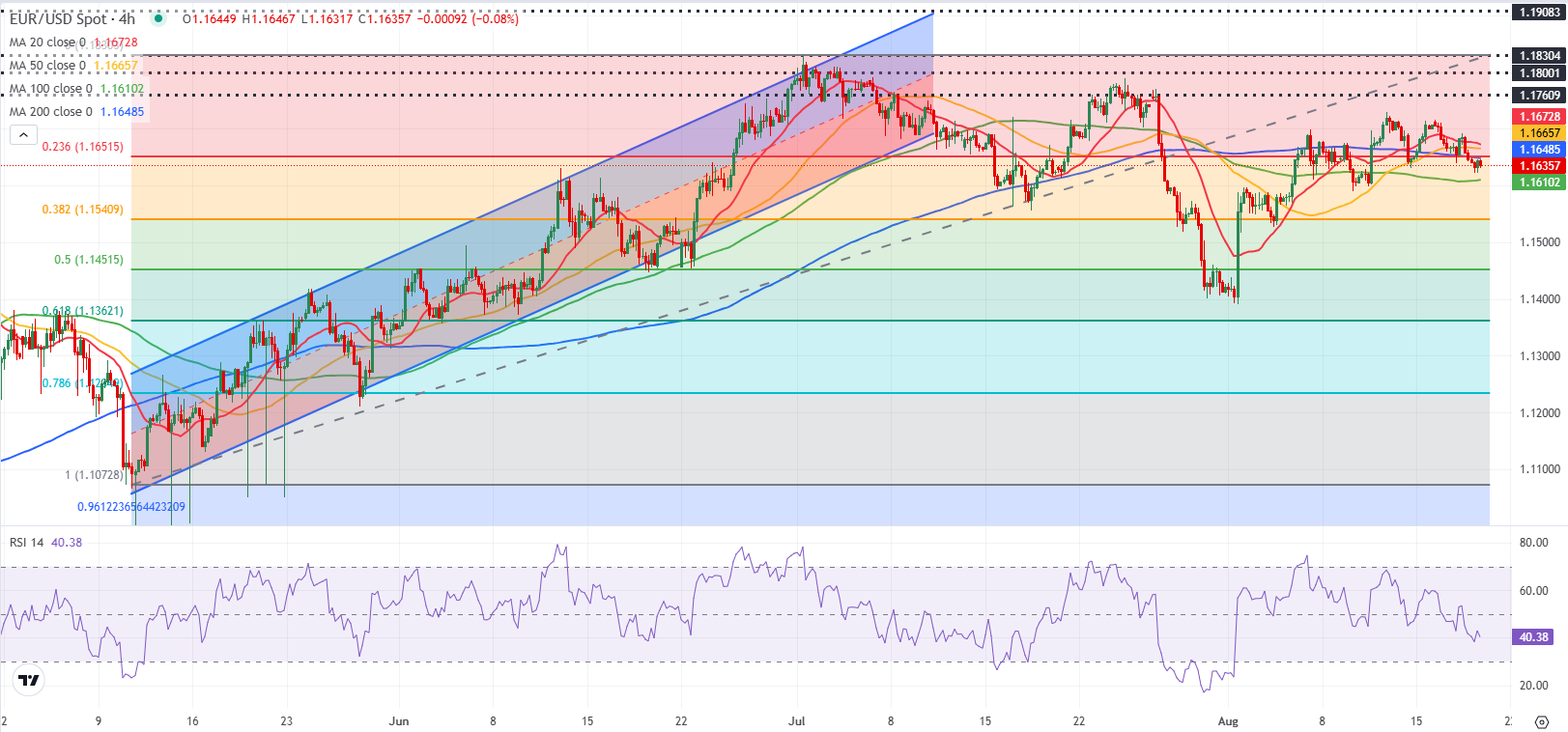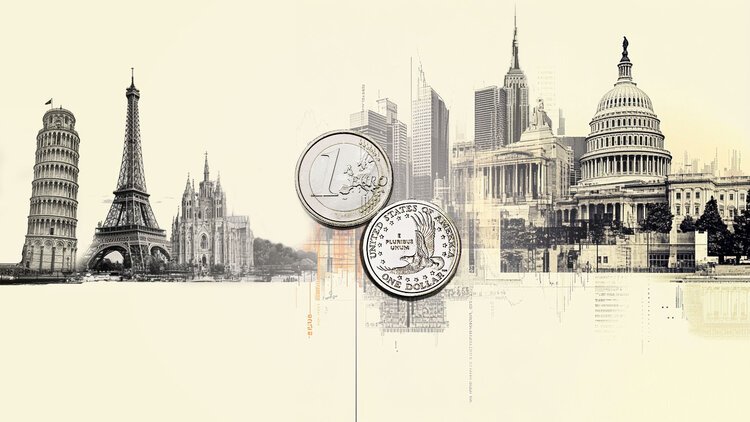- EUR/USD trades in a tight range slightly below 1.1650 on Wednesday.
- The Fed will release the minutes of the July policy meeting.
- The technical outlook hints at a bearish tilt in the near term.
EUR/USD struggles to gain traction and trades slightly below 1.1650 in the European session on Wednesday after posting small losses on Tuesday. The pair’s near-term technical outlook highlights a lack of buyer interest as investors wait for the Federal Reserve (Fed) to publish the minute of the July policy meeting later in the day.
Euro PRICE This week
The table below shows the percentage change of Euro (EUR) against listed major currencies this week. Euro was the weakest against the US Dollar.
| USD | EUR | GBP | JPY | CAD | AUD | NZD | CHF | |
|---|---|---|---|---|---|---|---|---|
| USD | 0.65% | 0.39% | 0.25% | 0.44% | 1.16% | 1.62% | 0.31% | |
| EUR | -0.65% | -0.27% | -0.43% | -0.21% | 0.51% | 0.93% | -0.34% | |
| GBP | -0.39% | 0.27% | -0.26% | 0.06% | 0.78% | 1.20% | -0.12% | |
| JPY | -0.25% | 0.43% | 0.26% | 0.21% | 0.92% | 1.40% | 0.06% | |
| CAD | -0.44% | 0.21% | -0.06% | -0.21% | 0.69% | 1.17% | -0.18% | |
| AUD | -1.16% | -0.51% | -0.78% | -0.92% | -0.69% | 0.42% | -0.89% | |
| NZD | -1.62% | -0.93% | -1.20% | -1.40% | -1.17% | -0.42% | -1.33% | |
| CHF | -0.31% | 0.34% | 0.12% | -0.06% | 0.18% | 0.89% | 1.33% |
The heat map shows percentage changes of major currencies against each other. The base currency is picked from the left column, while the quote currency is picked from the top row. For example, if you pick the Euro from the left column and move along the horizontal line to the US Dollar, the percentage change displayed in the box will represent EUR (base)/USD (quote).
Following a bullish beginning to the week, the US Dollar (USD) preserved its strength on Tuesday and caused EUR/USD to stretch lower as markets adopted a cautious stance.
Early Wednesday, US stock index futures lose between 0.2% and 0.3% on the day, suggesting that investors continue to stay away from risk-sensitive assets.
The US economic calendar will not offer any high-impact data releases on Wednesday. Hence, investors will pay close attention to comments from Fed officials. CME Group FedWatch Tool currently shows that markets are currently pricing in about an 83% probability of a 25 basis-points rate cut in September. In case policymakers voice their willingness to ease the policy at the next meeting, the market positioning suggests that the USD has some room on the downside.
Later in the American session, the Fed will release the minutes of the July policy meeting. If this publication shows that policymakers want to see more convincing signs of tariffs not causing a steady increase in inflation before easing the policy further, the USD could continue to outperform its rivals and weigh on the pair.
EUR/USD Technical Analysis

The Relative Strength Index (RSI) indicator on the 4-hour chart declined to 40 and EUR/USD closed the last four 4-hour candles below the 20-period and the 50-period Simple Moving Averages (SMAs), reflecting a bearish tilt in the near term.
EUR/USD faces a pivot level at 1.1650, where the 200-period SMA, the Fibonacci 23.6% retracement of the latest uptrend, the 20-day SMA and the 50-day SMA converge. Once this level is confirmed as resistance, technical sellers could take action. In this scenario, 1.1610-1.1600 (100-period SMA, round level) could be seen as an interim support level before 1.1540 (Fibonacci 38.2% retracement) and 1.1500 (static level, round level).
If EUR/USD manages to stabilize above 1.1650 and uses this level as support, resistance levels could be seen at 1.1720 (static level), 1.1760 (static level) and 1.1800 (static level, round level).
Euro FAQs
The Euro is the currency for the 19 European Union countries that belong to the Eurozone. It is the second most heavily traded currency in the world behind the US Dollar. In 2022, it accounted for 31% of all foreign exchange transactions, with an average daily turnover of over $2.2 trillion a day.
EUR/USD is the most heavily traded currency pair in the world, accounting for an estimated 30% off all transactions, followed by EUR/JPY (4%), EUR/GBP (3%) and EUR/AUD (2%).
The European Central Bank (ECB) in Frankfurt, Germany, is the reserve bank for the Eurozone. The ECB sets interest rates and manages monetary policy.
The ECB’s primary mandate is to maintain price stability, which means either controlling inflation or stimulating growth. Its primary tool is the raising or lowering of interest rates. Relatively high interest rates – or the expectation of higher rates – will usually benefit the Euro and vice versa.
The ECB Governing Council makes monetary policy decisions at meetings held eight times a year. Decisions are made by heads of the Eurozone national banks and six permanent members, including the President of the ECB, Christine Lagarde.
Eurozone inflation data, measured by the Harmonized Index of Consumer Prices (HICP), is an important econometric for the Euro. If inflation rises more than expected, especially if above the ECB’s 2% target, it obliges the ECB to raise interest rates to bring it back under control.
Relatively high interest rates compared to its counterparts will usually benefit the Euro, as it makes the region more attractive as a place for global investors to park their money.
Data releases gauge the health of the economy and can impact on the Euro. Indicators such as GDP, Manufacturing and Services PMIs, employment, and consumer sentiment surveys can all influence the direction of the single currency.
A strong economy is good for the Euro. Not only does it attract more foreign investment but it may encourage the ECB to put up interest rates, which will directly strengthen the Euro. Otherwise, if economic data is weak, the Euro is likely to fall.
Economic data for the four largest economies in the euro area (Germany, France, Italy and Spain) are especially significant, as they account for 75% of the Eurozone’s economy.
Another significant data release for the Euro is the Trade Balance. This indicator measures the difference between what a country earns from its exports and what it spends on imports over a given period.
If a country produces highly sought after exports then its currency will gain in value purely from the extra demand created from foreign buyers seeking to purchase these goods. Therefore, a positive net Trade Balance strengthens a currency and vice versa for a negative balance.







